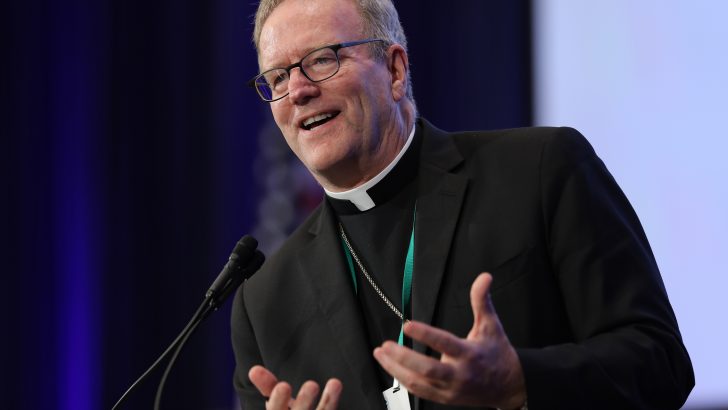An Irish stonemason, with little education, became one of the great evangelists of the last century. And his story is now entwined with the famous American bishop Robert Barron, himself the son of Irish emigrants, whose Word on Fire network has gone global.
I heard the story at St Comgall’s School on the Falls Road school the other day, where the new Bishop of Down and Connor, Alan McGuckian, had gathered priests and laity for a networking lunch, aimed at encouraging Catholics to share their faith with others.
Mission
The story goes back to November 14, 1940, when John Forbes, a Belfast-born stonemason at Coventry Cathedral was on nightwatch.
Hitler’s Luftwaffe was raining down bombs, killing six hundred people and injuring thousands and Forbes saw that an incendiary bomb had smashed through the roof of the Cathedral. His thoughts turned to his wife and children.
Forbes tore through the city, ignoring an order from a policeman to go to the bunker – where he almost certainly would have perished as the bunker suffered a direct hit.
When Forbes arrived at his bomb-damaged street, heart pounding in his mouth, he was grateful to find his own house still standing, his wife and family safe inside.
The next day he went to work at Coventry Cathedral and found a ruin.
Where others found despair, Forbes saw only hope.
Although the Cathedral had no roof, Forbes got to work, declaring: “Every church needs an altar.” He saw that two charred pieces of timber formed the shape of a cross and fashioned them with string alongside a makeshift altar of rubble.
His works still stand today, along with the words of Christ which he wrote: “Father forgive them for they know not what they do…”
Forbes’ grandson, Brenden Thompson who told the story, is himself now a full-time evangelist as UK Programme Director for Word on Fire.
Thompson’s tale was tailor-made for the Belfast event – where two questions dominated: why don’t more Catholics share their faith – and how do we get them to evangelise?
Bishop McGuckian told delegates this was vital. “The fundamental mission of the church isn’t to transform us into ‘pious catechetical know-it-alls’ who stand at a distance and wag their fingers at the world,” he said. “Whatever we do must transform us into captivating Christians. We have to have God make Christians of us so we have something to share with other people”
He said evangelisation must be attractive and creative, done with an open heart, a heart that burns so other hearts can burn also.
One of the lessons of the Covid lockdown, from which the Church is still recovering. Post-covid, around 40% of mass-goers did not return”
Bishop McGuckian’s own encounter with Bishop Barron’s new evangelisation came in the year of faith, 2012, when he was given his DVD set, entitled Catholicism. “I was just blown away,” he said.
Soon 72 people from Down and Connor were sent out to share the series with 2,000 parishioners. “It made a big difference,” said Bishop McGuckian.
But anyone who has ever kindled a fire knows, it needs constant attention, one of the lessons of the Covid lockdown, from which the Church is still recovering. Post-covid, around 40% of mass-goers did not return.
One of the luncheon speakers, Dr Gladys Ganiel, a sociologist from Queen’s University Belfast, said fewer women than men returned.
She spoke about the decline in church attendance and the rise of the ‘nones’ – those who do not identify with any faith.
In fact, Dr Ganiel said there are indications that women are becoming less religious than men. One theory is that men are seeking answers in a shifting world where roles are changing and phrases such as “toxic masculinity” are increasingly common.
A survey of the Chaplaincy at Queen’s University in turn showed women were also more likely to disagree with the church on hot-button issues such as abortion and same-sex marriage.
There was some intriguing news though. A 2023 survey by the Evangelical Alliance in Northern Ireland revealed a new trend among Catholics, particularly young Catholics. Almost 40% of Catholics now are “evangelical” – something almost unheard of 20 years ago. The figure rises to 70 percent among younger Catholics, aged 18-24.
So what is holding the others back? Some say a lack of confidence, a lack of awareness, and a lack of knowledge.
“How can you evangelise what you don’t know?” asked Brenden Thompson.
Belief
Vatican II made changes to the way the catechism was taught. My own Irish Catholic mother, who was born in 1942, left school at 14. She learned the doctrinal rules by rote and shared her ‘penny catechism’ with her children.
But when I discovered feminism I had no real understanding of Church teaching on issues such as women’s ordination. A child of Vatican II, I was not given even a ‘penny catechism’ and was in high school when the bishops formally decided to publish the official new Catechism. I was too busy reading newspapers as a working journalist by the time Pope John Paul II published the Catechism of the Catholic Church in 1992.
This is one of our problems as a Church. Too many ‘lay faithful’ do not know the faith and are formed by the media. A recent column in The Irish News by Bronagh Diamond, highlighted the disaster.
When the roof caves in, the fire of love, which cannot be quenched, is a good place to start”
This young woman had the gift of a ‘penny catechism’ granny and said she believed in God, but saw no reason to leave the comfort of her home on Sunday to go to mass (so that we living stones can be transformed in love and become more Christ-like). I won’t repeat what Ms Diamond wrote about the Eucharist. Forbes’ makeshift placard “Father forgive…” suffices.
But this young woman recounted a telling anecdote about a classroom of children who were asked if they believed in God. Only three hands went up.
Perhaps they were asked the wrong question. Perhaps the question needs to be: Do you believe in love?
After all, John the Evangelist tells us, “God is love”.
When the roof caves in, the fire of love, which cannot be quenched, is a good place to start.
**
“White Christians” were among those being blamed for Donald Trump’s stunning victory in the US election.
Christians have long been handy scapegoats.
The fact is many Christians of all races were divided sharply between Donald Trump and Kamala Harris – though she dismissed Christians pretty quickly from her pre-election rally.
The ‘Social justice’ left-leaning Catholics in particular seem to champion Harris, prizing ‘feeding the poor’ over ‘life for the poorest of the poor’, the children in the womb. The Democratic candidate, Kamala Harris was a very weak candidate who lost for complex reasons, despite having so many advantages (positive press coverage, massive funding and Trump’s many failings).
But Harris lacked vision, and was unable to articulate values that resonated with the American people. Her main platform often focussed on access to abortion, and she celebrated the choice to destroy small children in the womb for any reason up to birth in the name of ‘freedom’. This should be abhorrent to all, not just Christians.
Does the left hand even know what the far left hand is doing?


 Martina Purdy
Martina Purdy Bishop Robert Barron. Photo: CNS.
Bishop Robert Barron. Photo: CNS. 